My better half was recently and suddenly admitted to hospital with a previously unsuspected medical condition. I’m glad to say that she responded to treatment and was discharged after a week with a course of medication and instructions to take it easy for a time.
So while she rested upstairs for a couple of hours in the afternoons I retreated higher up. To the loft, where for some time I have been building a model railway.
Now, I am not talking about some highly detailed creation accurate to the last rivet, far from it. It started as a plain oval of track to run my collection of vintage Hornby tinplate trains and just seemed to grow. No plastic kits here, everything is made in the traditional way from wood, card and paper very much as I remember my father doing in the nineteen-fifties. I suppose, looking at it psychologically, that’s what I’m doing: reliving childhood memories. Family and friends have been regularly bored with digital snaps of its progress but, with time on my hands, I decided to see what I could do with film in the hope that the resulting images would be more idiomatic.
The first two attempts made with my Minolta SR7 and a 35mm lens resulted in barely salvageable underexposed images but at least gave me a list of things to concentrate on:
- Length of exposure and the need to experiment to overcome reciprocity failure which was greater than I had expected
- Lighting, which in my case was nothing more sophisticated than a hand-held inspection lamp to supplement the ceiling lights
- Make sure that the verticals are indeed vertical
- Composition to avoid jarring distractions in the background as much as possible
- Focus to take full advantage of depth of field
I was right at the limit of the closest focussing range of the 35mm Rokkor but rather than try if I could do better with a 50mm Rokkor so as to be further back the devil in me prompted to use, and thereby test, a recently acquired Exa 500 which came with a Zeiss 50mm that had the advantage of stopping down to f22.
An Exa 500 was featured on 35mmc few years ago so I won’t say any more about mine at this stage other than that as far as looks go I find it pleasing to the eye in a dumpy, left-handed Hausfrau sort of way. To make it feel at home I even used Fomapan 100, instead of my usual FP4 , and took a chance with increased exposure times.
I had already found the easiest way to ensure vertical verticals and obtain a manageable area to be kept in focus was to adopt a “straight on” viewpoint, but as it wasn’t my intention to create a panorama, those sort of images, looked at individually, turned out to be too similar.
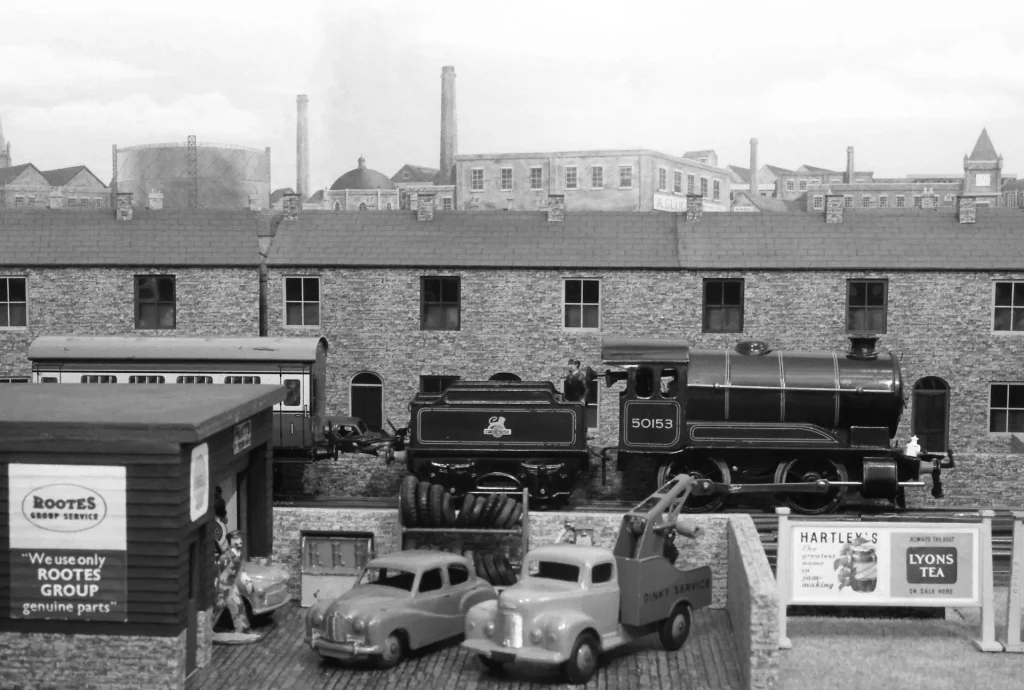
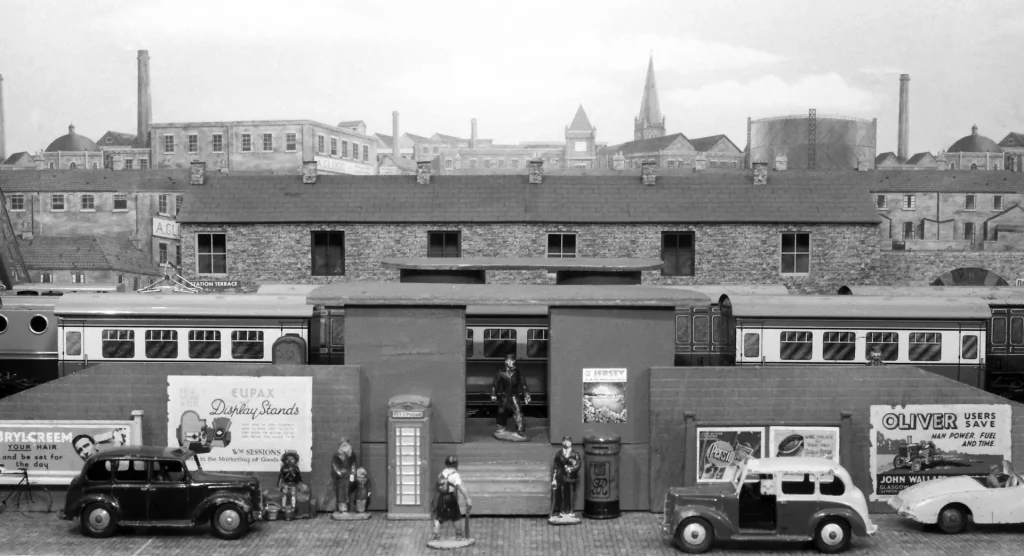
I was pleased with the classic railway photograph look obtained by stopping down to f22 and taking careful notice of the depth of field by using a tape measure.
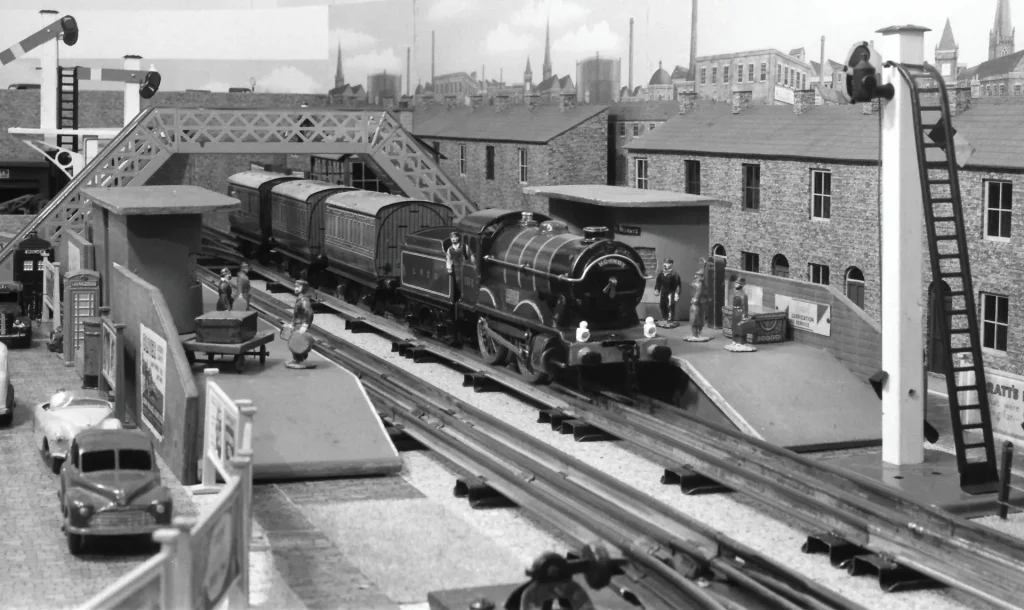
However, the problem with this one is obvious: the gap in the backscene is all too visible at the top left of the frame. The eye, even through a viewfinder, often ignores what it doesn’t want to see. A photograph concentrates the attention and is less forgiving. Although I’m no great lover of post-processing beyond the basic things I used to do in a darkroom I did make make an attempt to cover the gap with a bit of digitally added sky. Whether this improves the image or is considered cheating is, of course, purely subjective so I’m offering both versions of the same frame.
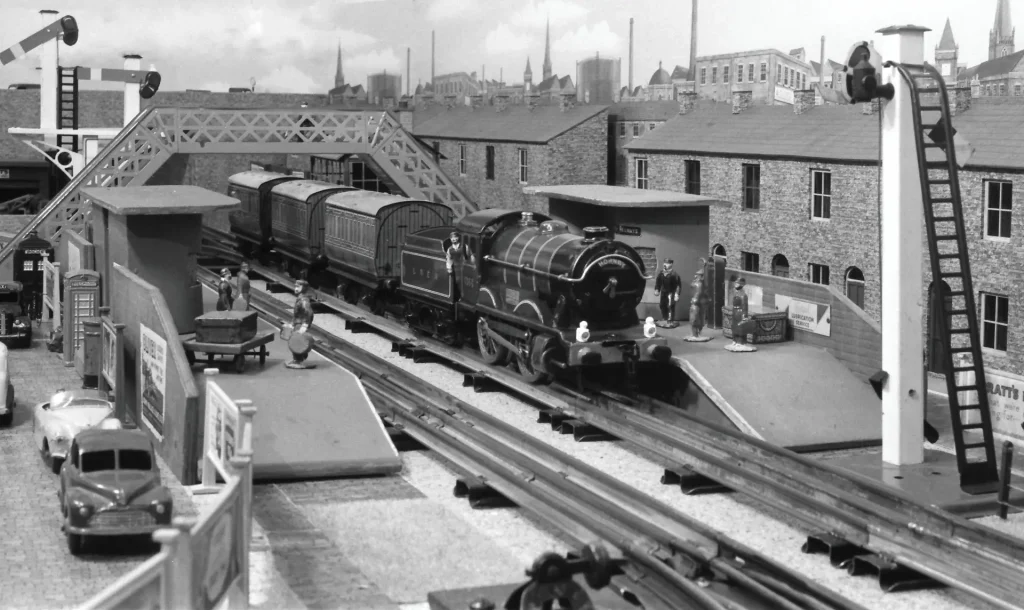
Emboldened by that, all I did with this shot of the other side of the layout was to shade the top of the backscene to soften its top edge.
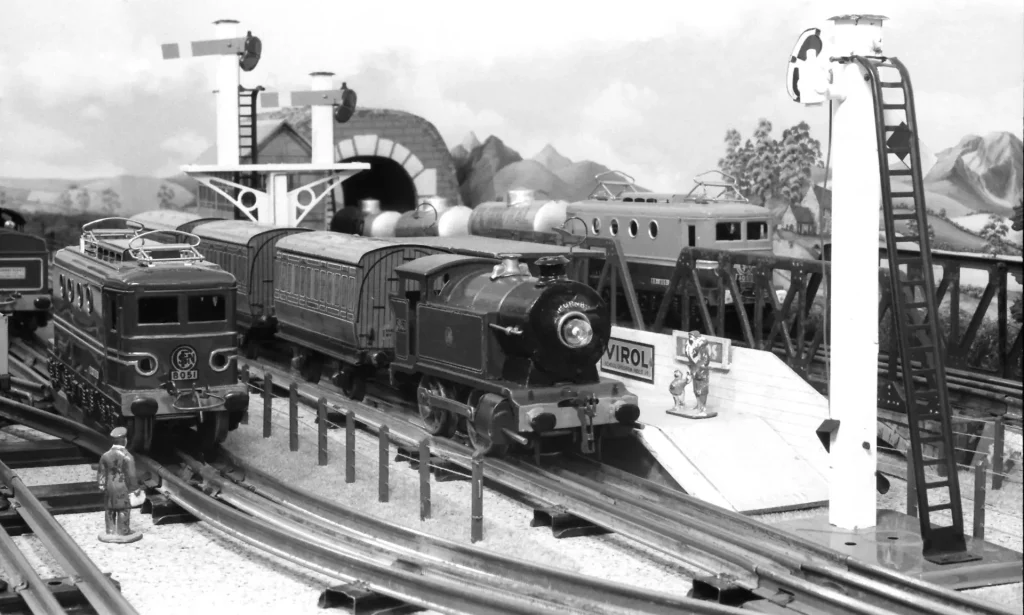
Luckily, my favourite image required no such tweaking. The idea for this started as another “straight on” shot but when positioning things I realised that a change of angle would be better. I just wish I had placed a figure waiting on the other side of the level crossing.
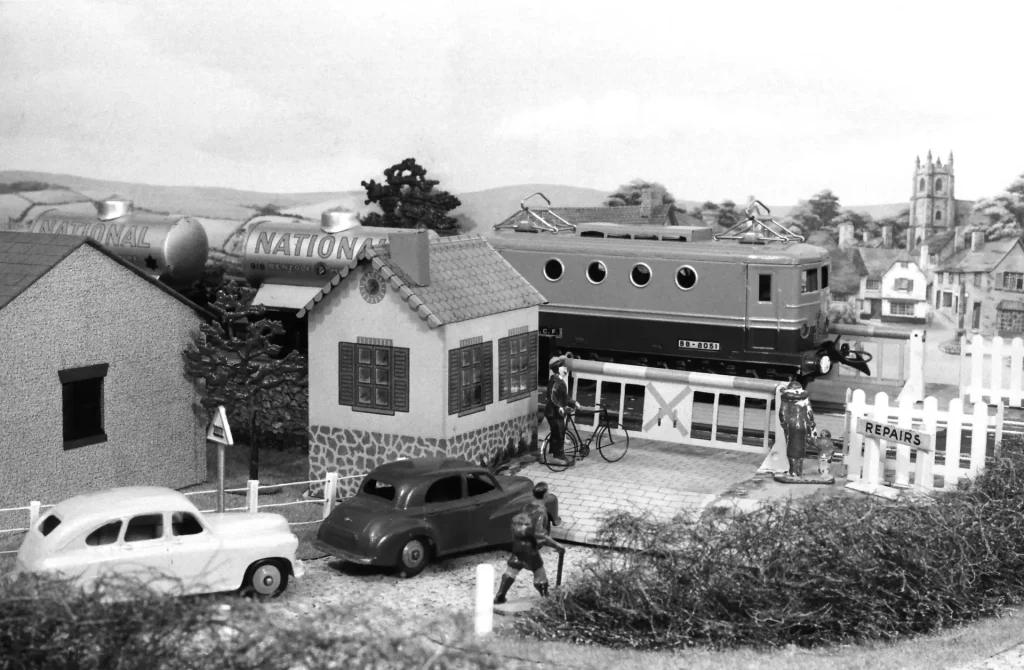
Summer, even a British one, makes it too hot and stuffy in the loft to stay there for any length of time but until the weather cools down I’ve come away from this little exercise with a couple of things to mull over. As far as the railway is concerned the inadequacies of the backscene have been exposed (no pun intended) and need rectifying. Photographically, an angle finder attachment or something with a waist-level finder would certainly make composition easier and enable me to try other viewpoints using a table tripod.
Reverting to the Exa, how did that perform? There were a couple of minor glitches which, unless the old girl is worn out, may correct themselves with use. The wind-on didn’t cock the shutter on three occasions resulting in frames lost by having to wind on again and on one occasion the shutter didn’t fully open leaving a black bar at the bottom of the frame. Oh, and the first roll of film I used in it was wasted. I’d rewound it right back into the canister as I didn’t feel the usual drag of the leader coming off the take-up spool. Not having a leader extractor I resorted to the old trick of fishing it out with a piece of wetted film. When developed it was completely blank apart from a completely overexposed first frame. A dry run with the back of the camera off using an old film revealed that the leader must have slipped off the take-up spool because, not wishing to use too much force, I hadn’t pushed it far enough into the rather stiff retaining tongue. Quite how much I’ll enjoy its quirky quaintness using it handheld rather than on a tripod with cable release attached remains to be seen.
If you’ve persevered this far, thanks for reading.
Share this post:
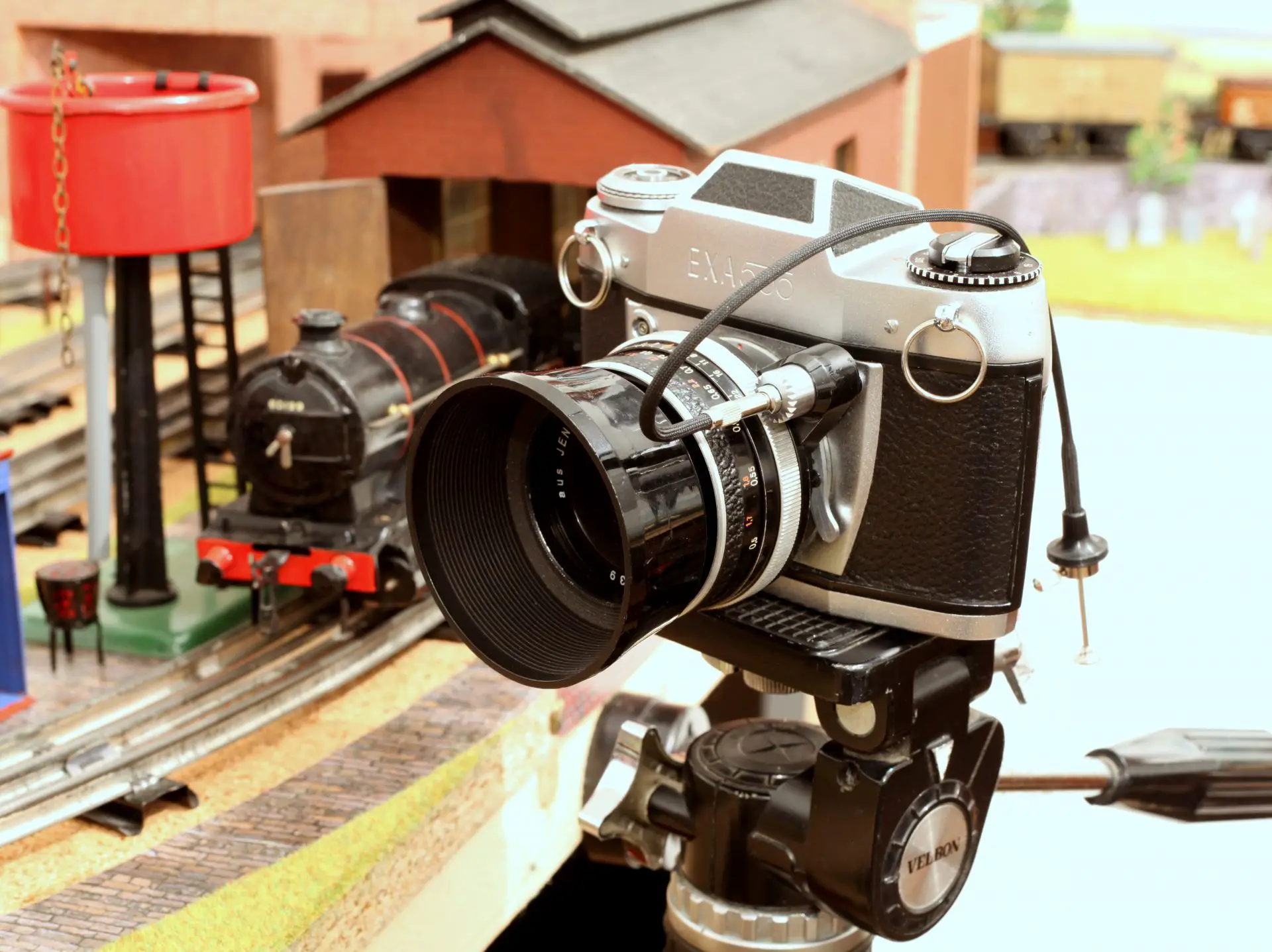








Comments
Michael J on 5 Frames of Miniature Nostalgia with an Exa 500 – By Peter Roberts
Comment posted: 21/07/2021
Comment posted: 21/07/2021
Martin South of France on 5 Frames of Miniature Nostalgia with an Exa 500 – By Peter Roberts
Comment posted: 21/07/2021
Comment posted: 21/07/2021
Terry B on 5 Frames of Miniature Nostalgia with an Exa 500 – By Peter Roberts
Comment posted: 21/07/2021
It reminds me of the layout my father built for me around 1952 not long after he left the Navy, but on a smaller and less ambitious scale using Hornby OO gauge. There were two engines, a 0-6-0 side tank shunting engine in GWR livery, and a nice black 4-6-2 LMS. He used Trix track as it was easy to run both trains on the same track layout. Triang carriages as they had interior illumination. Unfortunately for him and all his effort, I didn't take to model railways! I much preferred getting out on my three wheel Triang bike.
Comment posted: 21/07/2021
John Tarrant on 5 Frames of Miniature Nostalgia with an Exa 500 – By Peter Roberts
Comment posted: 21/07/2021
Comment posted: 21/07/2021
Comment posted: 21/07/2021
Comment posted: 21/07/2021
Comment posted: 21/07/2021
Charles Higham on 5 Frames of Miniature Nostalgia with an Exa 500 – By Peter Roberts
Comment posted: 21/07/2021
Comment posted: 21/07/2021
Rich on 5 Frames of Miniature Nostalgia with an Exa 500 – By Peter Roberts
Comment posted: 21/07/2021
Our train set only came out for Christmas, but it included a wooden station by one grandfather, and a mountain with a tunnel through it by the other. The mountain was made from chicken wire, toilet paper, and plaster. Unpainted, it wasn't realistic, but at Christmas, who cared?
Regards,
--Rich
Comment posted: 21/07/2021
Brian Nicholls on 5 Frames of Miniature Nostalgia with an Exa 500 – By Peter Roberts
Comment posted: 23/07/2021
Comment posted: 23/07/2021
Mark on 5 Frames of Miniature Nostalgia with an Exa 500 – By Peter Roberts
Comment posted: 24/07/2021
AND, that A40 Somerset model - nice in B&W. I have a full sized one in the shed: my first car, bought in 1980, still running - now, there’s potential for a real big layout.
So much in this story for me - thanks again, greetings from Toowoomba, Australia.
Comment posted: 24/07/2021
Kevin Thomas on 5 Frames of Miniature Nostalgia with an Exa 500 – By Peter Roberts
Comment posted: 26/07/2021
Comment posted: 26/07/2021